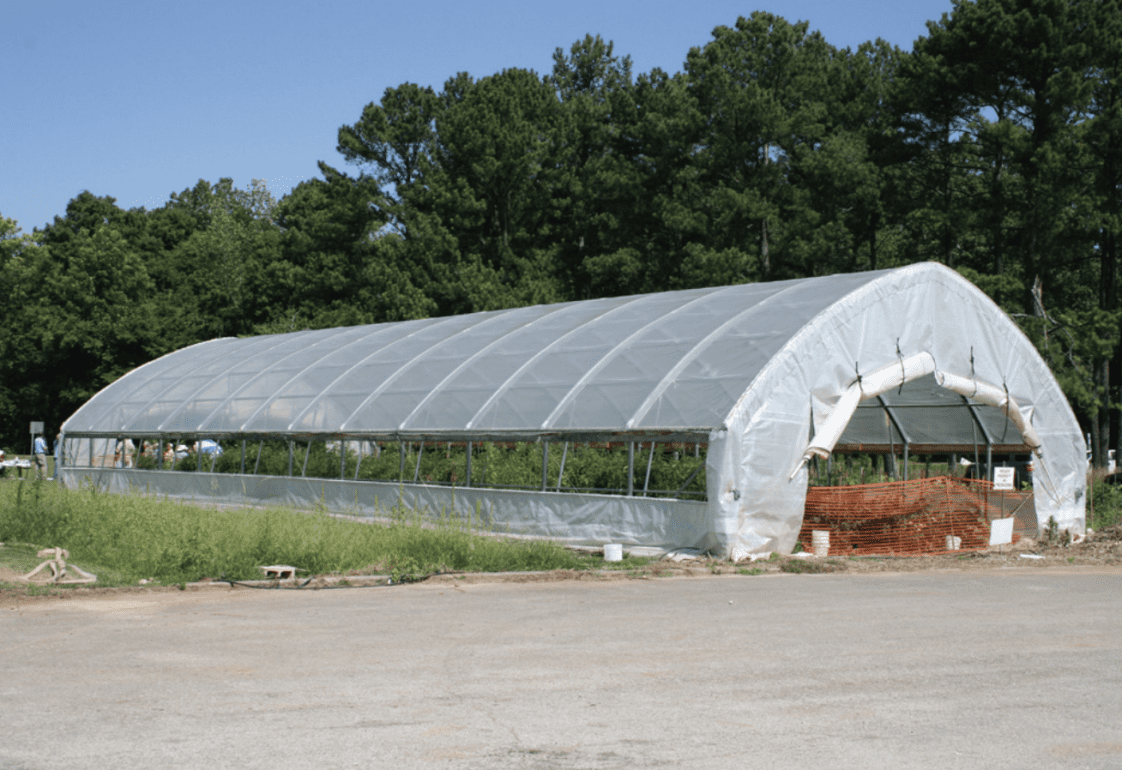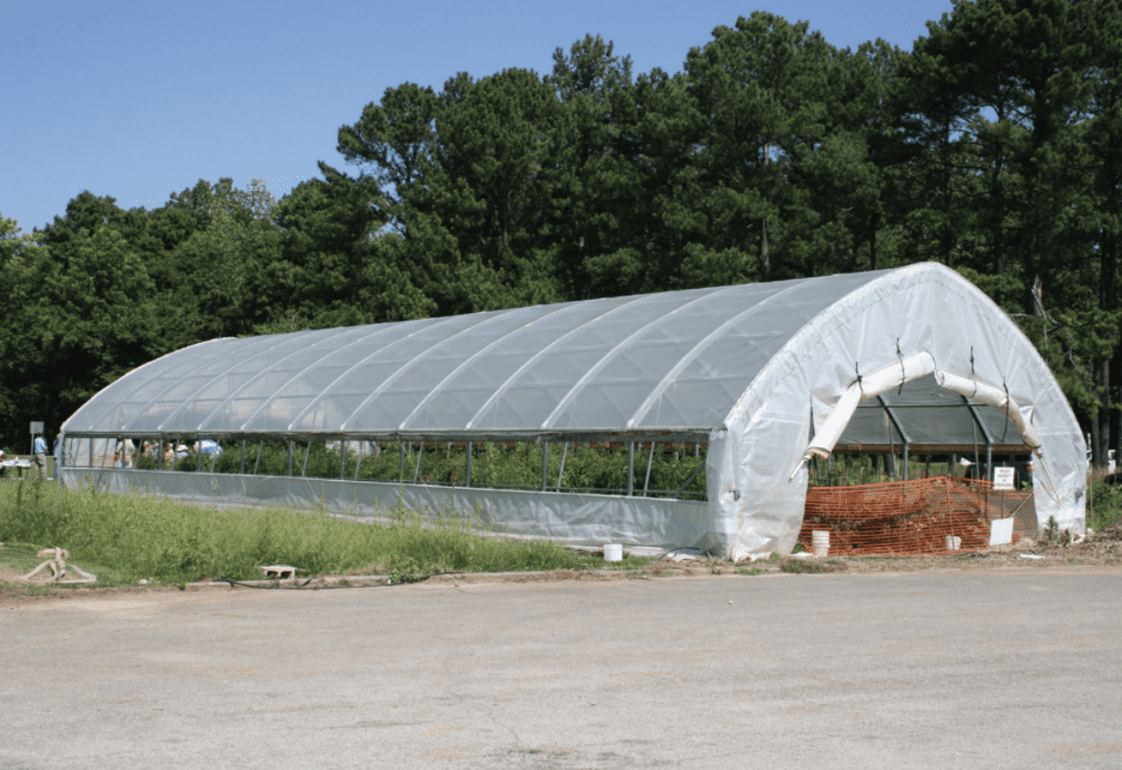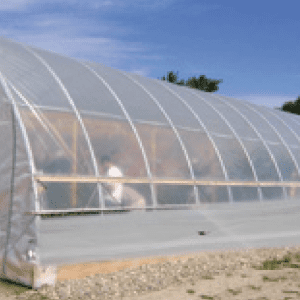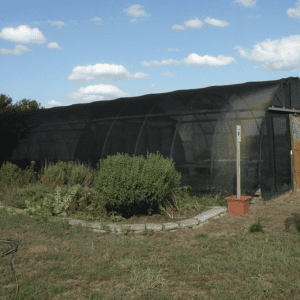Integrated Pest Management (IPM)

High tunnels are unheated, plastic-covered, structures, usually with passive ventilation through roll-up or roll-down side walls. Height varies from 6 feet to more than 17 feet, depending on the crop grown and the equipment used. Typical high tunnel dimensions range from 10’–30′ width × 9’–12′ height × any length (typically 96 feet for 100-foot long rolls of plastic).
When designing a high tunnel, consider equipment height with operator trellis or crop support needs. High tunnels have the following features:
- frame,
- side walls
- end walls
- cover
While your budget may limit your choice of materials, you may encounter problems if costs are cut significantly.
Frame

Figure 1. High tunnel structures can help producers extend
growing seasons. (Photo credit: Ayanava Majumdar)
Metal pipe is the strongest framing material for rib construction. Custom metal bending can be costly, but do-it-yourself kits can be purchased from a variety of sources. Metal frames can be heavy and difficult to maneuver, potentially restricting mobility of the structure.
PVC (polyvinylchloride) plastic pipe is an inexpensive material for rib construction. Plans are available for high tunnels using PVC with a construction budget beginning in the neighborhood of $200. However, frames constructed with PVC are weak and vulnerable to wind damage, and PVC tends to degrade rapidly in sunlight.
Most high tunnel framework is not constructed to support crops. Reinforce the frame if you are going to use it as part of your crop support. Planning ahead is the key for a cost-efficient and structurally sound frame.
End Walls
End walls offer support, access, and ventilation. Hip board running along the ribs can be connected to the end walls to provide additional support. The openings must be wide enough for workers to walk through with tools, supplies, or produce. On one end of the high tunnel, the opening is a regular or enlarged door for workers with tools. The opening on the other end provides access for equipment, such as tractors, rototillers, and vehicles.
Side Walls
Roll-up or roll-down side walls offer a simple way to manage temperature and promote ventilation. Because high tunnel ventilation is passive (not power- or fandriven), rolling up the sides allows warm air to exit. Temperature can be further manipulated by opening each side wall to varying heights at different times of the day.
Higher side walls are weaker than short side walls or high tunnels without side walls. However, the determining factor for side wall height should be the crop and equipment needs. If a tractor will be used, side walls must be at least the height of the tractor with ROPS (roll over protection structure) in the operating position. High tunnel structures with high side walls should be built strong enough to withstand severe weather.
Covers
Greenhouse-grade polyethylene, a plastic film, is the most common material used for covering high tunnels. Typical greenhouse grades of 4 to 6 mil polyethylene can be used in a single-layer covering or a double-layer covering. The double layer is twice as expensive, but the air between the two layers will serve as an insulator, will help moderate temperatures, and will reduce moisture dripping from above onto the plants. This option requires a small electrical fan to inflate the plastic and is, therefore, not usually used with high tunnels.
Shade cloth is made from knitted polyethylene strands or woven polyester and is water permeable. While it is often used in combination with a plastic covering, shade cloth is also used as the sole covering for a high tunnel. Knowledge of crop light, temperature, and season is necessary to determine shade cloth needs. Shade cloth is purchased by the percentage of light blocked—20 percent to 90 percent cloths are commonly available.
Insect Netting
Synthetic fabric or insect netting of appropriate mesh can be used on the side walls when rolled up (figure 2). This may reduce moths and other flying insect pests from getting to the host plants. Some producers have also successfully used shade cloth over unused high tunnel frames to serve as a net house for crop production and agritourism (figure 3).
- Figure 2. A typical high tunnel structure. (Photo credit: Ayanava Majumdar)
- Figure 3. Net house using high tunnel frame. (Photo credit: Ayanava Majumdar)
Consult the regional Extension agent in your area for updates or thorough consultation before and as you start high tunnel crop production. Extension also offers regional fruit and vegetable production meetings and training field days to help growers stay updated on new crop production technologies. The organic initiative in commercial horticulture provides support to small and low-resource farmers. Producers can apply for grants through the Alabama SARE program at www.southernsare.org/SARE-in-Your-State/Alabama.
For more information
- High Tunnel – www.hightunnels.org/
- How to Build a High Tunnel – www.uky.edu/Ag/NewCrops/hightunnel.pdf
- American Society of Plasticulture – http://plasticulture.psu.edu/?q=node/2
James Miles, former Regional Extension Agent, Mobile County; Ayanava Majumdar, Extension Entomologist, Auburn University
Reviewed August 2023, High Tunnel Construction, ANR-1434



